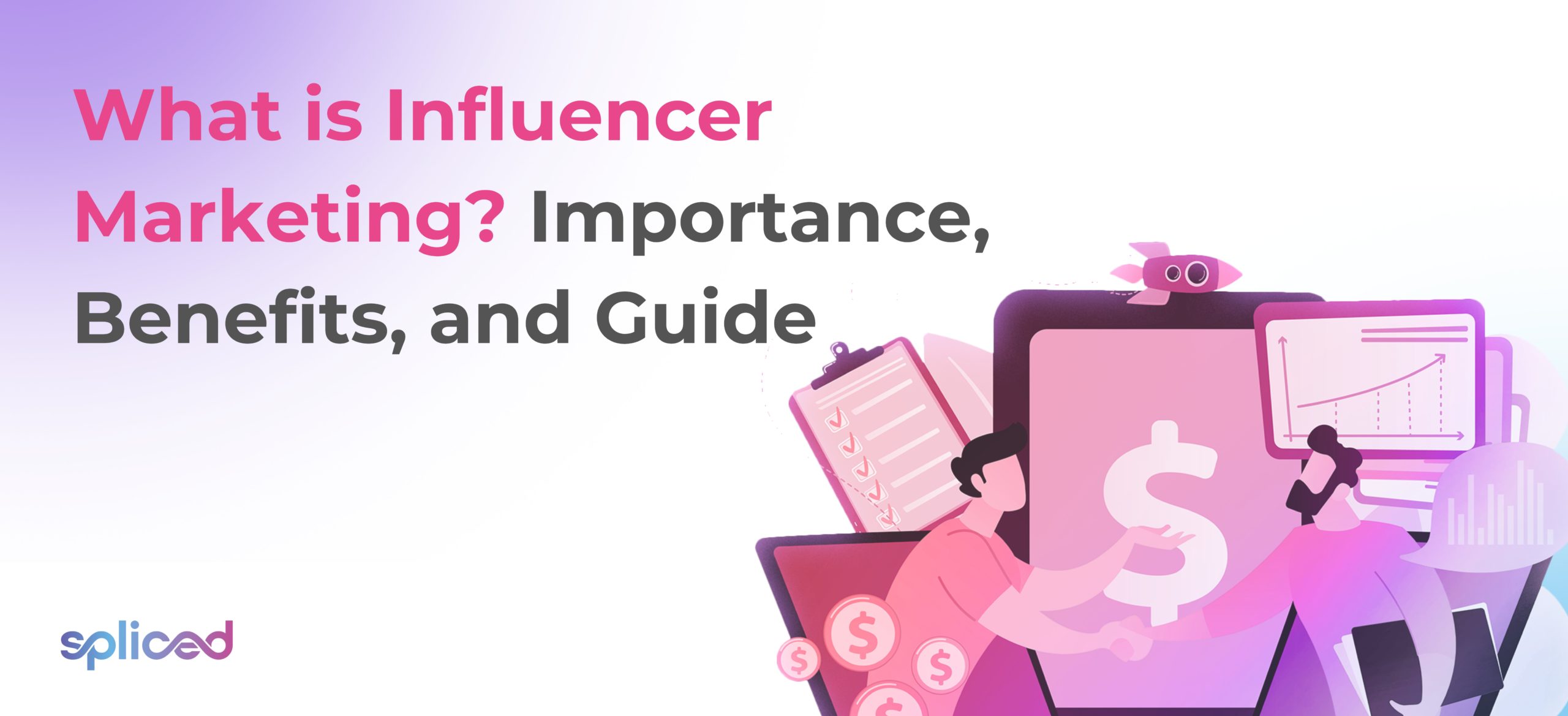Influencer marketing is a strategic approach in which businesses partner with individuals with significant influence, often on social media platforms, to endorse and publicize products, services, or brands. Influencer marketing is a marketing strategy that utilizes influencers’ credibility and expansive reach to engage and influence a wider target audience effectively.
The significance of influencer marketing is in its capacity to leverage the dedicated audience of influencers, offering a level of authenticity and relatability that is absent in traditional advertising strategies. The primary objective of implementing an influencer marketing approach is establishing enhanced and individualized connections with prospective customers, resulting in heightened brand recognition and improved sales performance.
Influencer marketing offers several advantages, such as increased brand visibility, focused audience engagement, enhanced trustworthiness and credibility, and a higher return on investment than traditional marketing approaches.
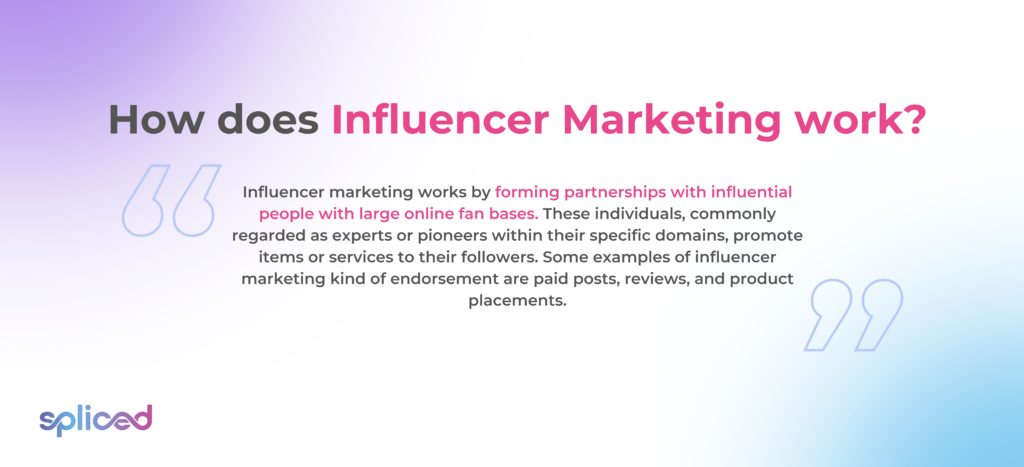
How does Influencer Marketing work?
Influencer marketing works by forming partnerships with influential people with large online fan bases. These individuals, commonly regarded as experts or pioneers within their specific domains, promote items or services to their followers. Some examples of influencer marketing kind of endorsement are paid posts, reviews, and product placements.
The trust and connection influencers establish with their followers results in heightened brand awareness and enhanced credibility for the associated business. The efficacy of influencer marketing is in its capacity to take advantage of the trust established by influencers with their audience, making it an effective mechanism for reaching and captivating potential customers more genuinely and naturally.
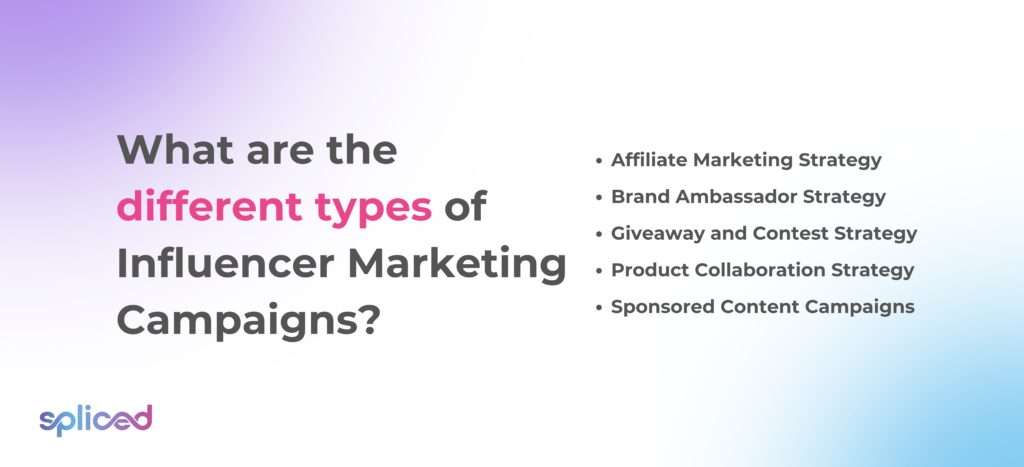
What are the different types of Influencer Marketing Campaigns?
The different types of influencer marketing campaigns are listed below.
-
- Affiliate Marketing Campaigns: Affiliate marketing campaigns involve influencers who employ distinct affiliate links or codes to endorse companies, earning a commission for each successful sale resulting from their promotional efforts.
-
- Brand Ambassador Campaigns: Brand ambassador campaigns involve the strategic engagement of influencers for an extended duration, during which they assume the role of representing the brand and consistently promoting its products.
-
- Giveaway and Contest Campaigns: Giveaway and contest campaigns collaborate with brands and influencers to organize competitions or freebies to foster audience engagement and increase brand visibility.
-
- Product Review Campaigns: Product Review Campaigns involve providing products to influencers, who then review them on their own platforms, providing honest evaluations and personal experiences.
-
- Sponsored Content Campaigns: Sponsored content campaigns involve the practice of brands compensating influencers to produce content that strongly showcases their product or service. Sponsored content campaigns are shared through the influencer’s many social media platforms.
The most effective campaign type is based on the brand’s specific objectives and target demographic. Sponsored content campaigns have gained significant popularity due to their natural authenticity and capacity to incorporate products within an influencer’s customary material easily. The efficacy of the types of influencer marketing campaigns is based upon several factors, including the influencer’s target demographic, the basic features of the product, and the extent to which the campaign matches the influencer’s personal brand and audience preferences.
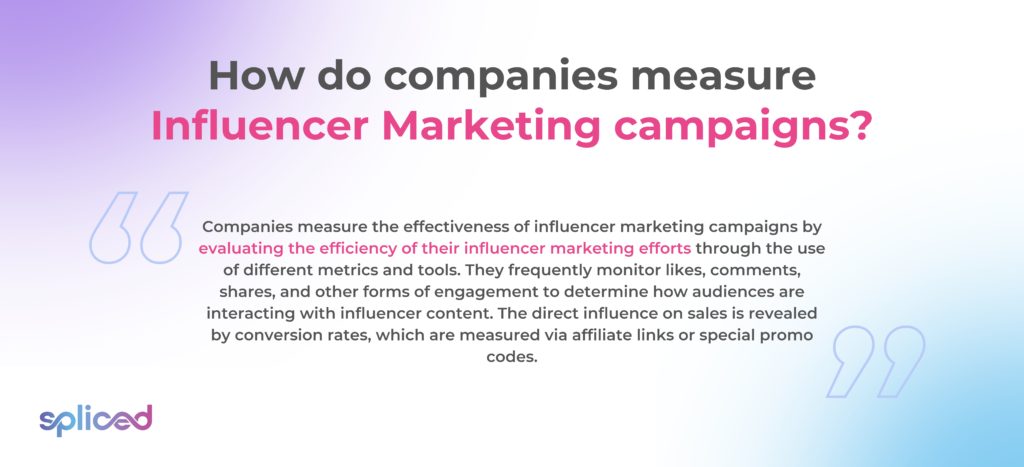
How do companies measure Influencer Marketing campaigns?
Companies measure the effectiveness of influencer marketing campaigns by evaluating the efficiency of their influencer marketing efforts using different metrics and tools. They frequently monitor likes, comments, shares, and other forms of engagement to determine how audiences interact with influencer content. The direct influence on sales is revealed by conversion rates, measured via affiliate links or special promo codes. Businesses engage in the practice of monitoring reach and impressions to gain insights into the extent to which their material is being viewed.
The use of sophisticated analytics tools provides valuable insights into the demographics and behavior of the audience, enabling businesses to evaluate the extent to which their campaign effectively reaches the intended target population. The evaluation of influencer marketing’s total efficacy is based on the extent of alignment between these measures and the primary marketing objectives, encompassing brand awareness, consumer engagement, and direct sales.
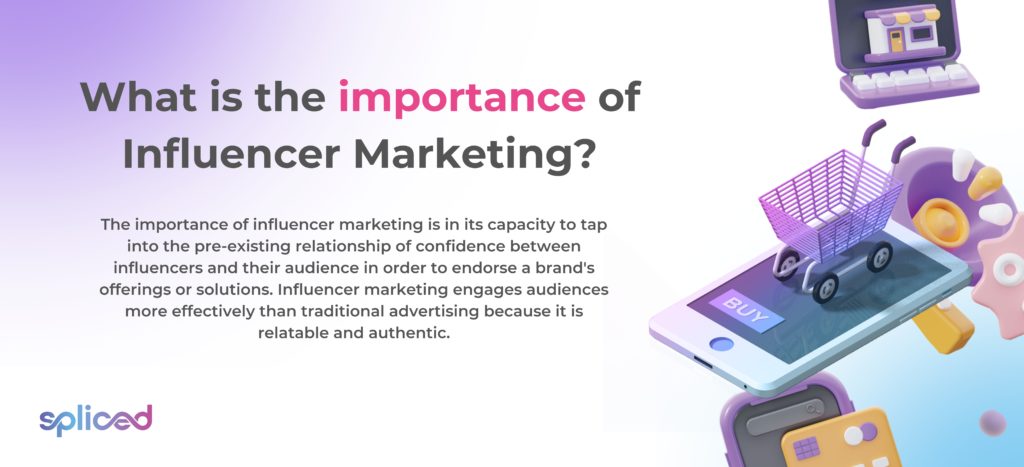
What is the importance of Influencer Marketing?
The importance of influencer marketing is in its capacity to tap into the pre-existing relationship of confidence between influencers and their audience to endorse a brand’s offerings or solutions. Influencer marketing engages audiences more effectively than traditional advertising because it is relatable and authentic.
Influencer marketing provides a focused means of reaching particular demographic segments, as influencers typically possess specialized and unique consumer groups. These targeted approaches lead to higher rates of involvement and potential conversion.
Influencer marketing lets brands make content that feels more personal and less intrusive, which fits how modern consumers want marketing to be real and approachable. Increased sales and customer loyalty frequently result from using such an approach to raise brand awareness and reputation.
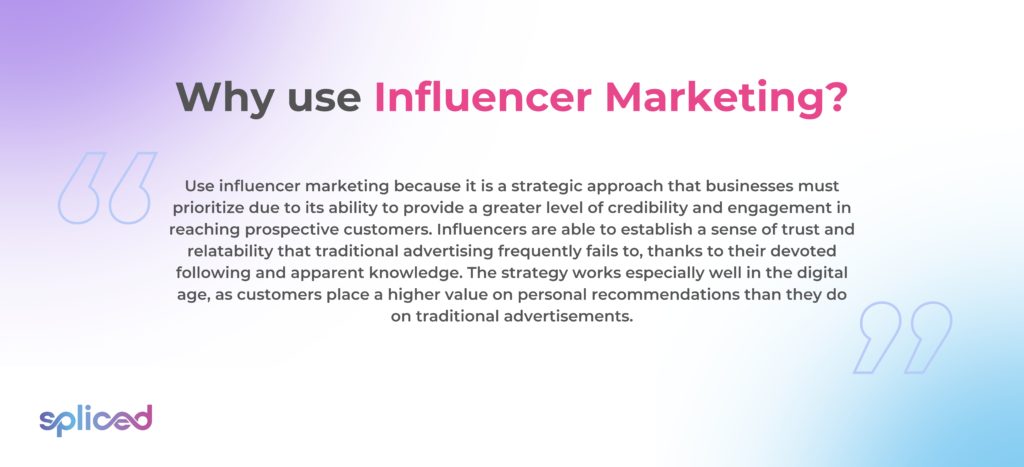
Why use Influencer Marketing?
Use influencer marketing because it is a strategic approach that businesses must prioritize due to its ability to provide greater credibility and engagement in reaching prospective customers. Influencers are able to establish a sense of trust and relatability that traditional advertising frequently fails to, thanks to their devoted following and apparent knowledge. The strategy works especially well in the digital age, as customers place a higher value on personal recommendations than they do on traditional advertisements.
Businesses are able to reach particular groups and niches through influencer marketing’s ability to provide customized outreach. It gives forth useful content that is able to be shared on several channels, raising brand awareness and potentially resulting in increased engagement and conversion rates.
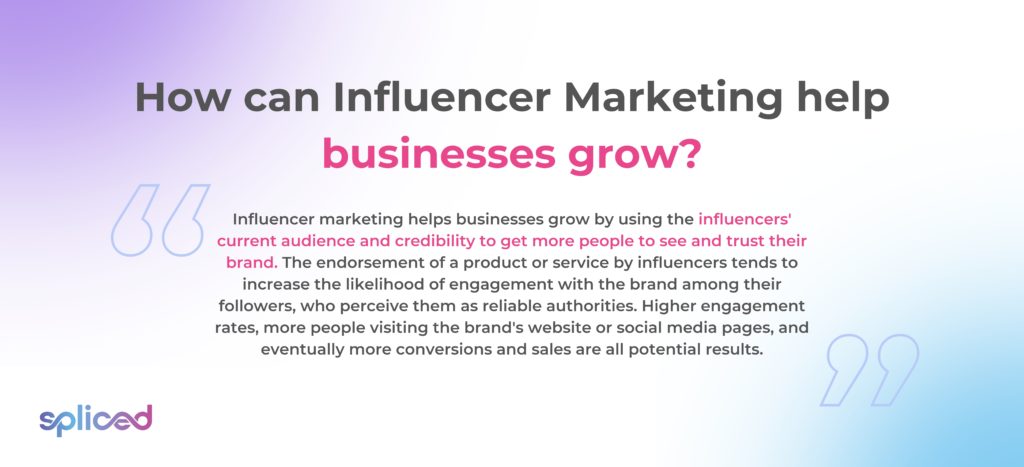
How can Influencer Marketing help businesses grow?
Influencer marketing helps businesses grow by using the influencers’ current audience and credibility to get more people to see and trust their brand. Influencers’ endorsement of a product or service tends to increase the likelihood of engagement with the brand among their followers, who perceive them as reliable authorities. Higher engagement rates, more people visiting the brand’s website or social media pages, and eventually, more conversions and sales are all potential results.
The use of influencer marketing has the potential to facilitate the introduction of a brand to previously untapped markets and demographics, enhancing its overall reach. The content generated by influencers additionally functions as useful marketing material that is recyclable throughout the brand’s exclusive channels, optimizing the campaign’s effectiveness.
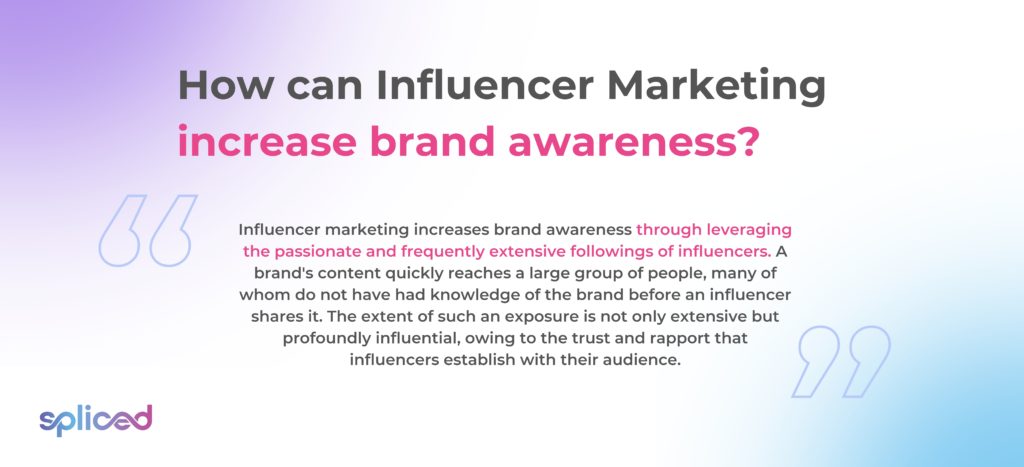
How can Influencer Marketing increase brand awareness?
Influencer marketing increases brand awareness by leveraging influencers’ passionate and frequently extensive followings. A brand’s content quickly reaches many people who do not know the brand before an influencer shares it. The extent of such exposure is extensive and profoundly influential, owing to the trust and rapport that influencers establish with their audience. For example, a beauty brand that works with a famous beauty influencer to launch a new product sees a big boost in brand awareness. It is because the influencer’s support brings the brand to the attention of a relevant and interested audience, which leads to more people knowing about and interested in the brand’s products.
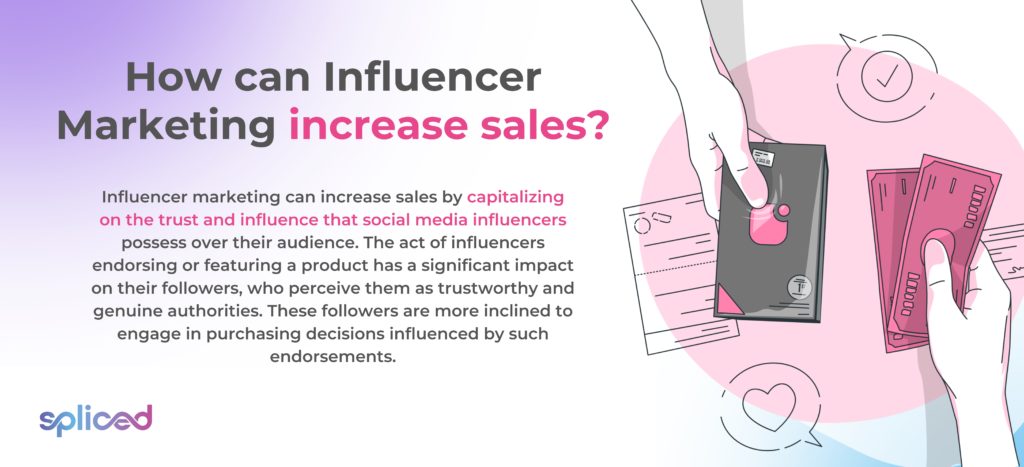
How can Influencer Marketing increase sales?
Influencer marketing can increase sales by capitalizing on social media influencers’ trust and influence over their audience. The act of influencers endorsing or featuring a product significantly impacts their followers, who perceive them as trustworthy and genuine authorities. These followers are more inclined to purchase decisions influenced by such endorsements. The impact is enhanced by strategic collaborations with influential individuals, guaranteeing that the product is exposed to a pertinent and engaged demographic.
The use of influencer marketing has the ability to facilitate organizations in attaining a more expeditious return on investment (ROI) as a result of the focused and captivating characteristics of the content. For example, collaborating with a well-known fashion influencer to launch a new clothing line immediately boosts sales since followers drawn to the influencer’s look are more likely to buy the highlighted products. The immediate impact on customer behavior has the potential to result in substantial increases in sales quickly.

How can Spliced improve Influencer Marketing for businesses?
Spliced can improve influencer marketing for businesses by providing streamlined tools that facilitate the identification and collaboration with influencers who are well-suited to their specific needs and objectives. Finding influencers whose followers are similar to the business’s target group is one of its features. Spliced makes communication and campaign management easier. Spliced most likely has analytics features, enabling companies to monitor campaign effectiveness and calculate ROI. Influencer marketing is easier and more effective for companies of all sizes with the all-inclusive method, which streamlines the process from campaign execution and evaluation to influencer selection and negotiation.
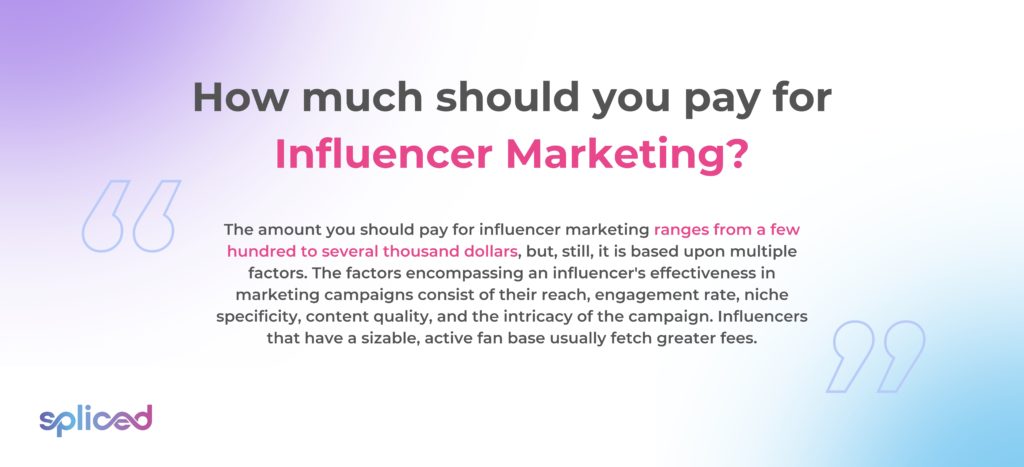
How much should you pay for Influencer Marketing?
The amount you should pay for influencer marketing ranges from a few hundred to several thousand dollars, but still, it is based upon multiple factors. The factors encompassing an influencer’s effectiveness in marketing campaigns consist of their reach, engagement rate, niche specificity, content quality, and the intricacy of the campaign. Influencers that have a sizable, active fan base usually fetch greater fees.
The pricing structure is influenced by the platform utilized, resulting in varying charges for Instagram influencers compared with competitors on YouTube or TikTok. The extent of the campaign, whether it comprises a solitary post or a sequence of posts, as well as any further stipulations such as exclusivity or content usage rights, exert an influence. The rates vary significantly, spanning from a few hundred to several thousand dollars. Familiarizing oneself with these criteria helps facilitate the process of negotiating equitable remuneration.
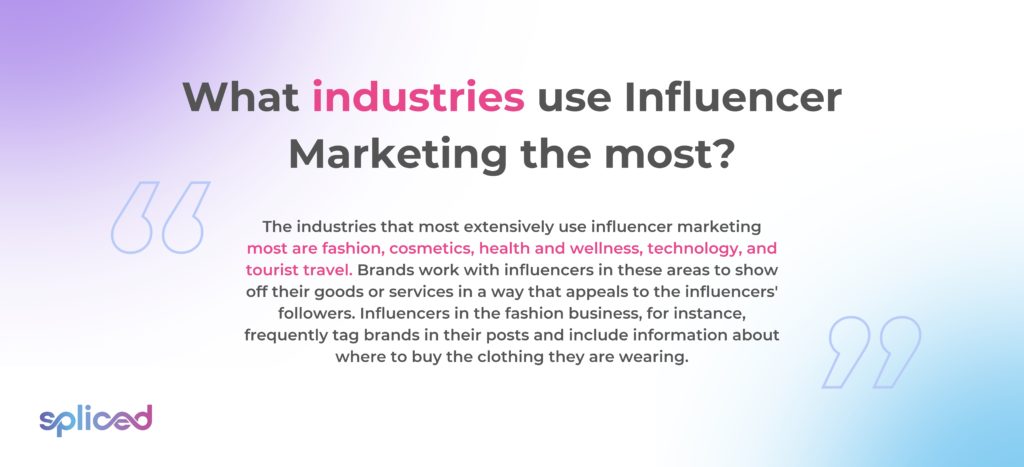
What industries use Influencer Marketing the most?
Fashion, cosmetics, health and wellness, technology, and tourist travel are the industries that most extensively use influencer marketing. Brands work with influencers in these areas to show off their goods or services in a way that appeals to the influencers’ followers. For instance, influencers in the fashion business frequently tag brands in their posts and include information about where to buy the clothing they are wearing. Influencers in the IT sector provide product reviews and usability tests of devices or software. These sectors utilize influencer marketing strategies to exploit influencers’ reputations and expansive reach, effectively engaging certain target demographics and generating brand recognition and sales.
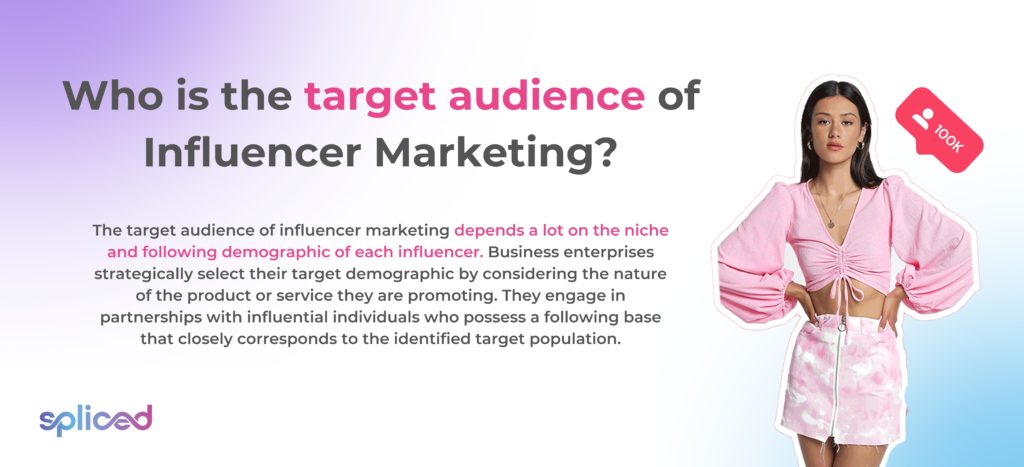
Who is the target audience of Influencer Marketing?
The target audience of influencer marketing depends a lot on each influencer’s niche and following demographic. Business enterprises strategically select their target demographic by considering the nature of the product or service they are promoting. They engage in partnerships with influential individuals with a following base that corresponds to the identified target population.
The target audience encompasses teenagers inclined toward fashion and beauty, professionals with a vested interest in technology, or individuals who are enthusiastic about fitness. An influencer audience is defined broadly as someone whose material and followers fit a certain demographic profile. The specialized strategy helps companies efficiently communicate with niche markets.
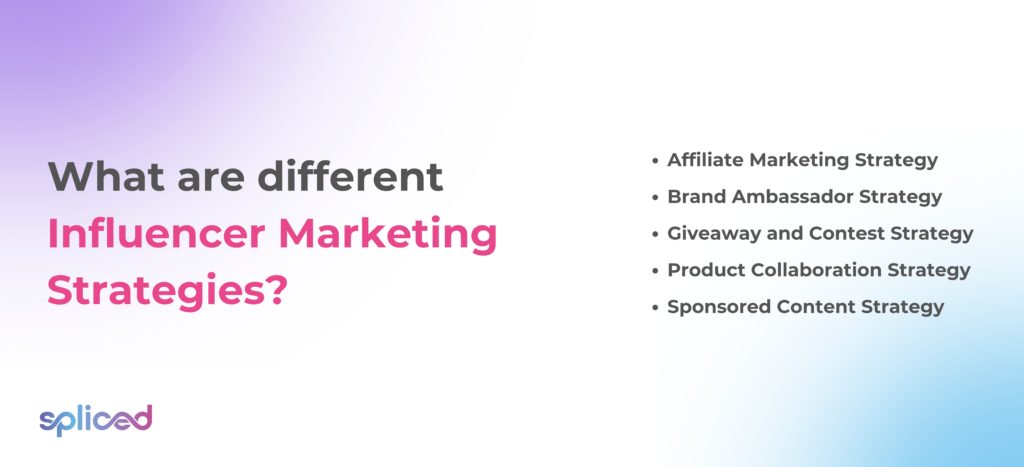
What are different Influencer Marketing Strategies?
The different influencer marketing strategies are listed below.
-
- Affiliate Marketing Strategy: The affiliate marketing strategy involves the utilization of influencers to endorse products through affiliate links, enabling them to get a commission for every successful transaction generated.
-
- Brand Ambassador Strategy: The brand ambassador strategy establishes enduring ties with influencers who continuously advocate for a company in exchange for various incentives.
-
- Giveaway and Contest Strategy: Strategy for Giveaways and competitions: Employing influencer collaborations to execute competitions or giveaways to involve the target audience and enhance product promotion actively.
-
- Product Collaboration Strategy: The product collaboration strategy involves the strategic partnership between brands and influencers to develop co-branded products, capitalizing on the influencer’s reputation and large audience base.
-
- Sponsored Content Strategy: Sponsored Content Strategy is one of the most used in influencer marketing strategies as it involves the practice of compensating influencers to produce content that prominently showcases the offerings of a certain business.
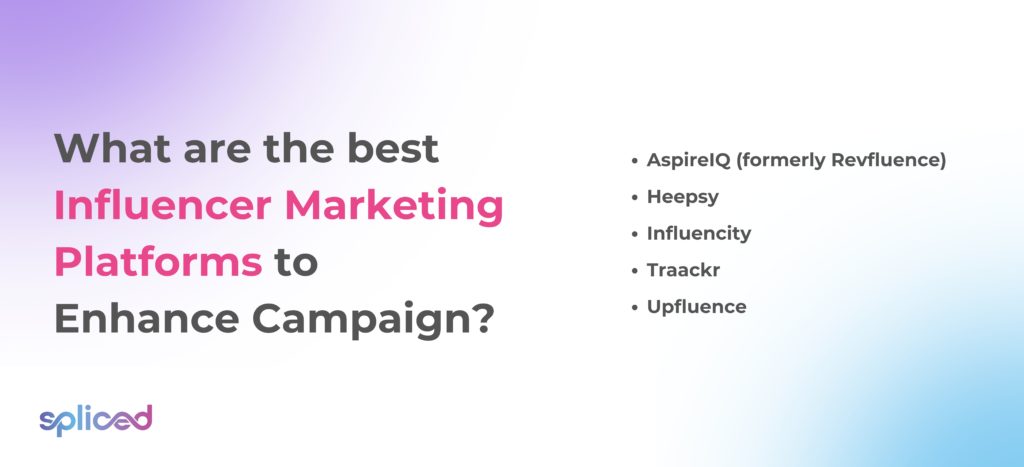
What are the best Influencer Marketing Platforms to Enhance Campaign?
The best influencer marketing platforms to enhance campaigns are listed below.
- Spliced: Spliced brings the latest technology and insights to influencer marketing, providing brands with a powerful suite of tools for managing influencer and affiliate partnerships. With direct integrations to Amazon and TikTok APIs, Spliced enables Amazon sellers to connect effortlessly, launching products faster and expanding their reach across multiple channels. The platform’s data-driven approach allows brands to assess influencer performance, track campaign success, and maximize engagement through precise targeting and real-time analytics.
Spliced is considered today one of the best platform to find amazon influencers given its level of deep connectivity with the Amazon Marketplace ecosystem. - AspireIQ (formerly Revfluence): AspireIQ (previously known as Revfluence) provides a comprehensive suite of technologies designed to effectively discover and oversee influencer relationships, allowing seamless collaboration between companies and influencers. It offers comprehensive marketing analytics.
- Heepsy: Heepsy is a platform that places emphasis on identifying influencers that possess genuine engagement and a substantial number of authentic followers. It offers organizations a range of tools to search for and analyze influencers based on diverse criteria.
- Influencity: Influencity is a platform that has been specifically developed to facilitate data-driven influencer marketing. It provides comprehensive analytics regarding the effectiveness of influencers and offers valuable insights into their audience demographics. Businesses are empowered to make well-informed decisions regarding their influencer marketing strategies by leveraging the information.
- Traackr: Traackr is renowned for its robust analytics and reporting capabilities, which enable organizations to assess the effectiveness of their influencer campaigns and efficiently handle influencer relationships on a large scale.
- Upfluence: Upfluence is a platform that seamlessly interfaces with eCommerce platforms and provides robust search functionalities. Upfluence enables brands to identify influencers based on precise parameters, such as audience demographics which makes it one of the best influencer marketing platforms.
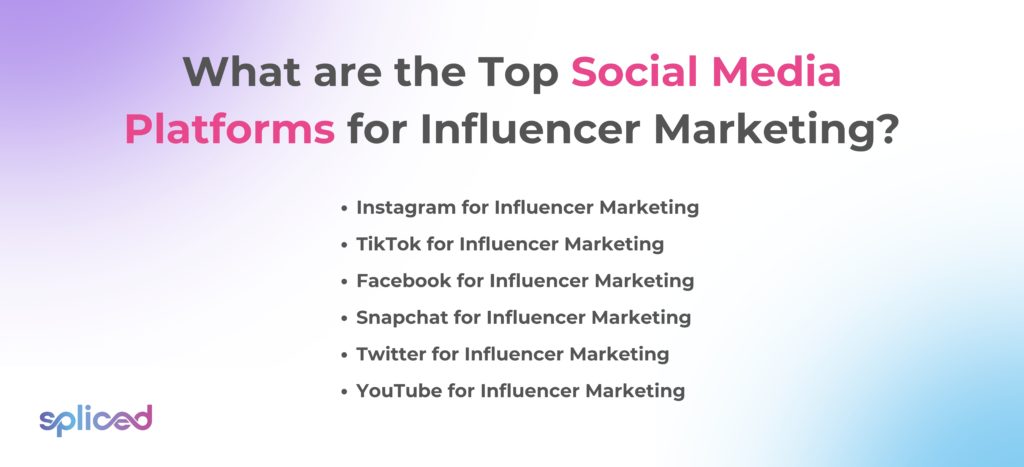
What are the Top Social Media Platforms for Influencer Marketing?
The top social media platforms for influencer marketing are listed below.
-
- Instagram for Influencer Marketing: Instagram is renowned for its notable levels of user engagement, making it an optimal platform for the dissemination of visually-oriented material and narrative-driven communication.
-
- TikTok for Influencer Marketing: TikTok, an increasingly expanding platform, has gained significant popularity among younger demographics due to its capacity to generate viral content and facilitate the creation of innovative short films.
-
- Facebook for Influencer Marketing: Facebook is an effective platform for influencer marketing due to its extensive user base, which encompasses a vast variety of demographics.
-
- Snapchat for Influencer Marketing: Snapchat has gained popularity as a platform for influencer marketing due to its unique feature of ephemeral material, which allows for real-time marketing opportunities and successful engagement with younger demographics.
-
- Twitter for Influencer Marketing: Twitter is a very effective platform for influencer marketing due to its ability to facilitate real-time engagement and capitalize on trending issues. The platform’s emphasis on short and compelling content makes it particularly well-suited for such purposes.
-
- YouTube for Influencer Marketing: YouTube is a highly suitable platform for influencer marketing, particularly for the creation and dissemination of long-form content. It proves to be highly effective in facilitating comprehensive product reviews, instructional videos, and engaging stories.
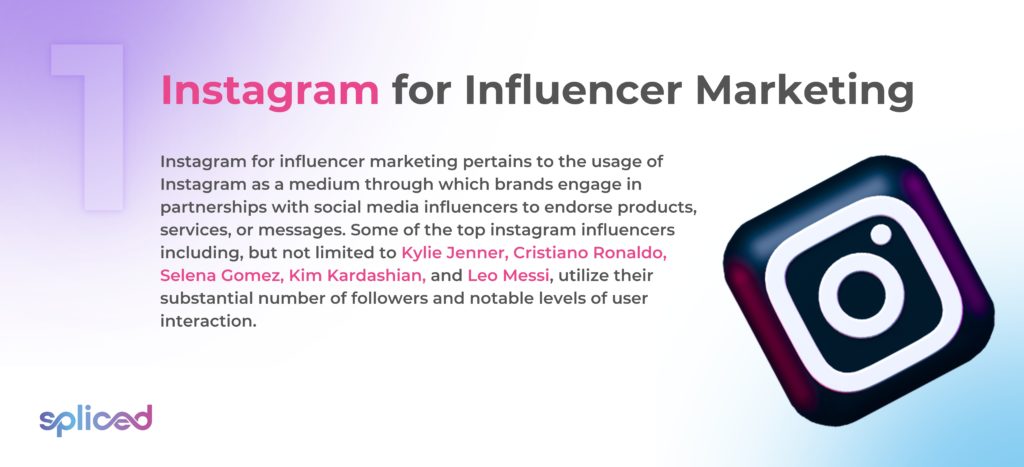
1. Instagram for Influencer Marketing
Instagram for influencer marketing pertains to the usage of Instagram as a medium through which brands engage in partnerships with social media influencers to endorse products, services, or messages. Some of the top instagram influencers including, but not limited to Kylie Jenner, Cristiano Ronaldo, Selena Gomez, Kim Kardashian, and Leo Messi, utilize their substantial number of followers and notable levels of user interaction to effectively present sponsored material in an aesthetically pleasing format.
One of the advantages associated with utilizing Instagram is its extensive user population, which provides a wide reach for businesses. The platform exhibits strong rates of user engagement, making it an effective tool for brand communication. Instagram’s emphasis on visually-oriented material makes it an ideal platform for brand storytelling and presenting products. Cons include the platform’s algorithm updates, which affects content visibility, saturation of sponsored content, and the potential problems with the legitimacy of influencer relationships.
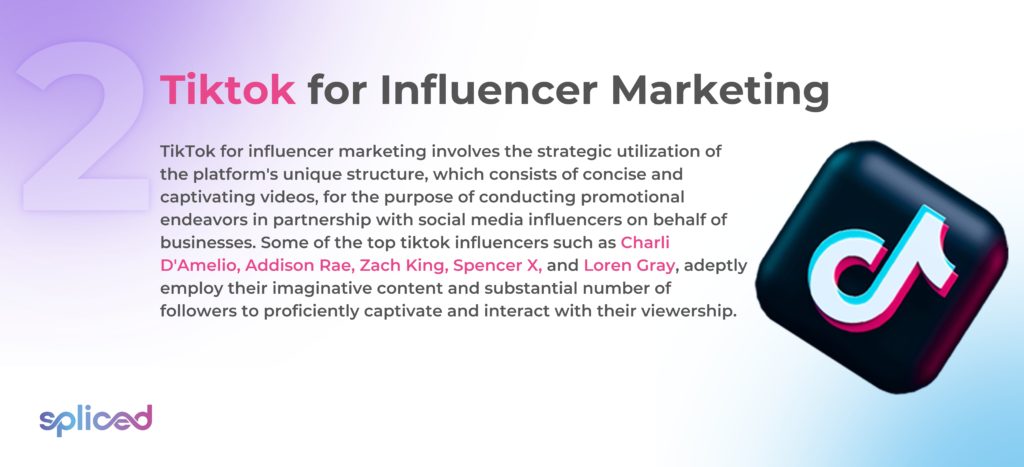
2. Tiktok for Influencer Marketing
TikTok for influencer marketing involves the strategic utilization of the platform’s unique structure, which consists of concise and captivating videos, for the purpose of conducting promotional endeavors in partnership with social media influencers on behalf of businesses. Some of the top tiktok influencers such as Charli D’Amelio, Addison Rae, Zach King, Spencer X, and Loren Gray, adeptly employ their imaginative content and substantial number of followers to proficiently captivate and interact with their viewership.
TikTok possesses several advantages, namely its exponential user growth, substantial levels of user engagement, and its capacity to facilitate the viral dissemination of content. Cons include the difficulty in calculating return on investment, the dynamic nature of viral events, and the comparatively younger consumers, which is not appropriate for all brands.
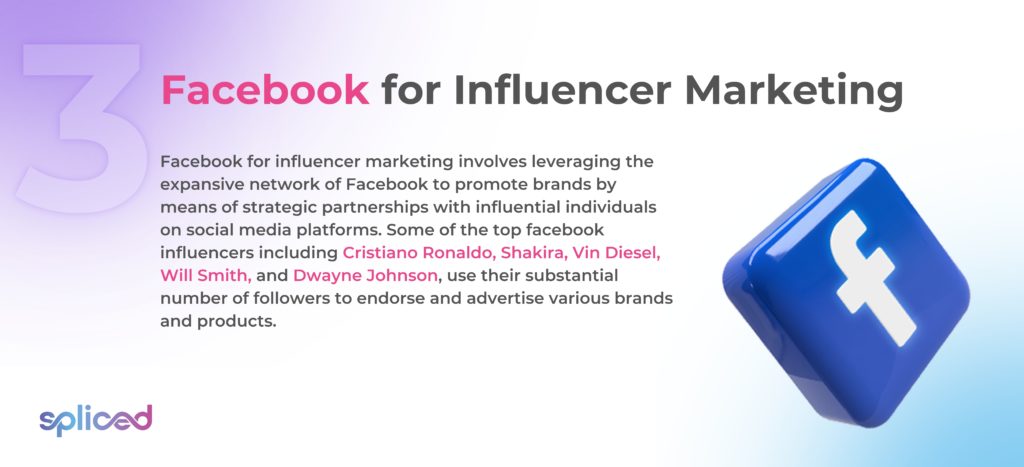
3. Facebook for Influencer Marketing
Facebook for influencer marketing involves leveraging the expansive network of Facebook to promote brands by means of strategic partnerships with influential individuals on social media platforms. Some of the top facebook influencers including Cristiano Ronaldo, Shakira, Vin Diesel, Will Smith, and Dwayne Johnson, use their substantial number of followers to endorse and advertise various brands and products.
One of the advantages of using Facebook is its extensive and diverse user population, as well as its comprehensive targeting capabilities. Cons include Facebook’s algorithm, which reduces organic reach; the platform’s formal, less impromptu style in comparison to more recent social networks; and potential difficulties in attracting younger audiences, who are more engaged on alternative platforms.
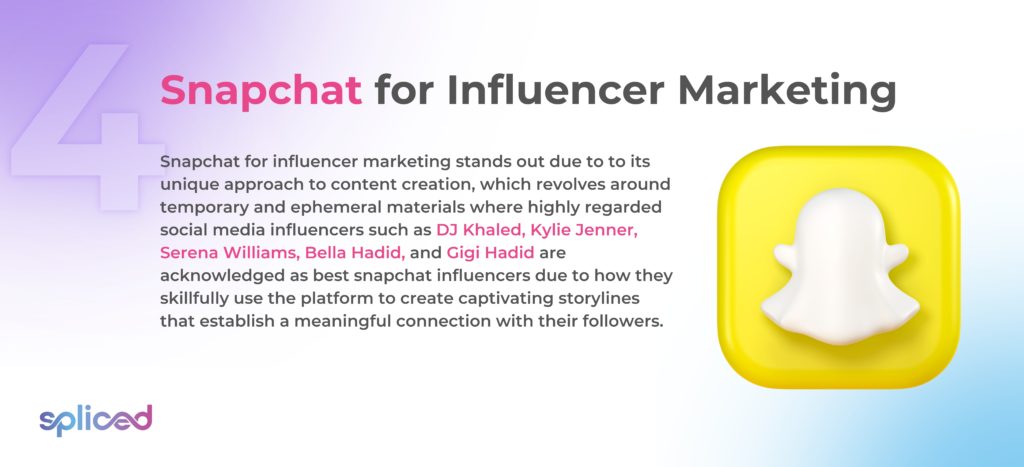
4. Snapchat for Influencer Marketing
Snapchat for influencer marketing stands out due to to its unique approach to content creation, which revolves around temporary and ephemeral materials where highly regarded social media influencers such as DJ Khaled, Kylie Jenner, Serena Williams, Bella Hadid, and Gigi Hadid are acknowledged as best snapchat influencers due to how they skillfully use the platform to create captivating storylines that establish a meaningful connection with their followers.
The practice of influencer marketing on the Snapchat platform frequently entails the creation and dissemination of content that is characterized by its spontaneous nature and personal touch, cultivating an atmosphere of realism and real-time engagement.
A higher engagement rate with younger audiences and a closer relationship with followers are two benefits of the strategy. Cons include the platform’s less extensive statistics when compared to other social media platforms and the fleeting nature of content, which restricts long-lasting influence.
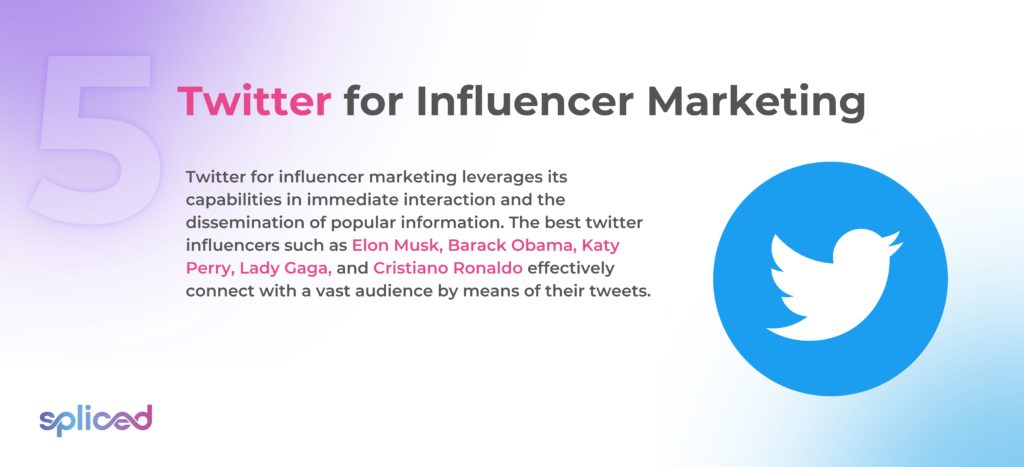
5. Twitter for Influencer Marketing
Twitter for influencer marketing leverages its capabilities in immediate interaction and the dissemination of popular information.The best twitter influencers such as Elon Musk, Barack Obama, Katy Perry, Lady Gaga, and Cristiano Ronaldo effectively connect with a vast audience by means of their tweets.
Influencer marketing on Twitter frequently revolves on current events, news, and trends, giving businesses the opportunity to participate in pertinent dialogues. One advantage of the platform is its capacity to effectively engage a wide range of individuals, thereby facilitating the dissemination of information to a diversified audience.
Twitter for influencer marketing’s platform natural characteristics make it well-suited for the delivery of clear and concise messages. Cons include the transient nature of tweet visibility and a chance of unfavorable comments or controversy because of the platform’s open and public character.
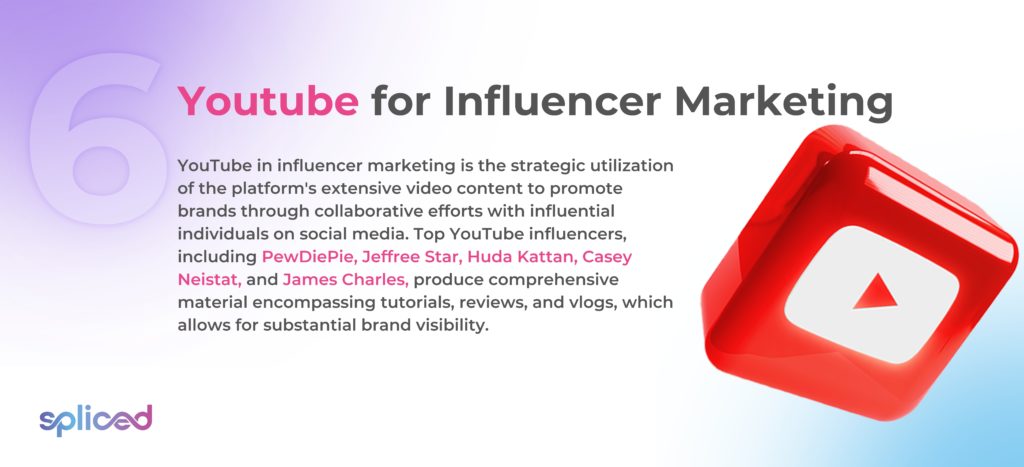
6. Youtube for Influencer Marketing
YouTube in influencer marketing is the strategic utilization of the platform’s extensive video content to promote brands through collaborative efforts with influential individuals on social media. Top YouTube influencers, including PewDiePie, Jeffree Star, Huda Kattan, Casey Neistat, and James Charles, produce comprehensive material encompassing tutorials, reviews, and vlogs, which allows for substantial brand visibility.
One advantage of utilizing online product presentations is the capacity to effectively communicate comprehensive product information and conduct demonstrations, fostering increased engagement and establishing trust. Cons include the high expense of producing high-quality video content and the fierce struggle for viewers’ attention on a platform that is overrun with content producers.
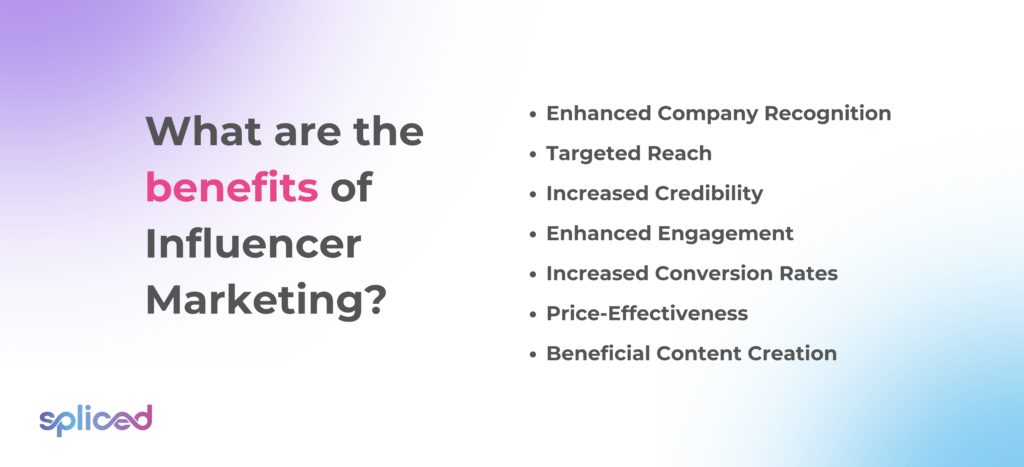
What are the benefits of Influencer Marketing?
The benefits of influencer marketing are listed below.
-
- Enhanced Company Recognition: Influencers possess the ability to expose a company to a broader or previously untapped demographic.
-
- Targeted Reach: Brands have the ability to effectively engage with certain demographic segments by leveraging the power of niche influencers.
-
- Increased Credibility: The endorsements of influencers have the potential to enhance the credibility and trustworthiness of a brand.
-
- Enhanced Engagement: Content created by influencers frequently exhibits elevated rates of engagement.
-
- Increased Conversion Rates: Influencers’ suggestions have the power to increase purchases.
-
- Price-Effectiveness: It is often cheaper compared to standard advertising.
-
- Beneficial Content Creation: Influencers generate original, genuine content that appeals to their audience.
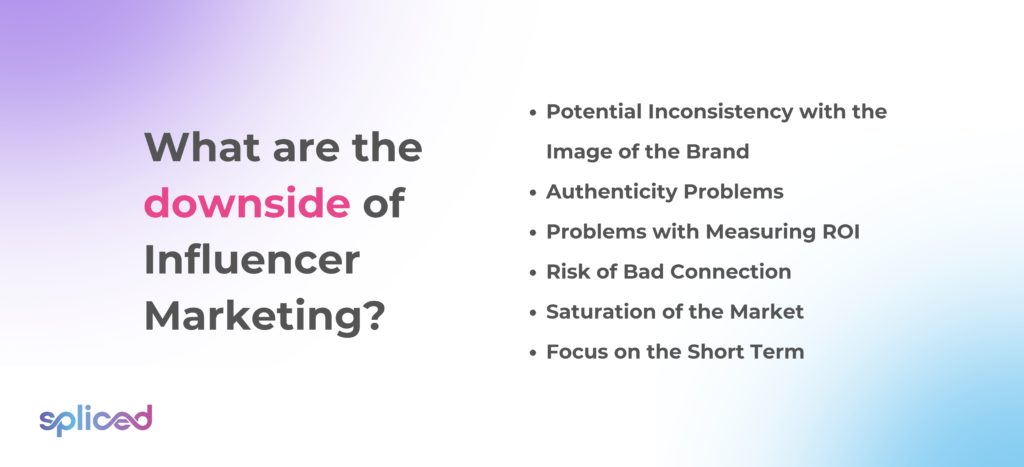
What are the downsides of Influencer Marketing?
The downsides of influencer marketing are listed below.
-
- Potential Inconsistency with the Image of the Brand: The potential risk of influencers lacking alignment with the values or image of the brand.
-
- Authenticity Problems: Using influencer relationships excessively raises concerns about authenticity.
-
- Problems with Measuring ROI: It is hard to figure out how much influencer efforts really help.
-
- Risk of Bad Connection: Hanging out with influential people who get involved in scandals.
-
- Saturation of the Market: There are too many influencers in the market, making it hard to stand out.
-
- Focus on the Short Term: Prioritizing short-term advantages above long-term brand building is a common practice in influencer efforts.
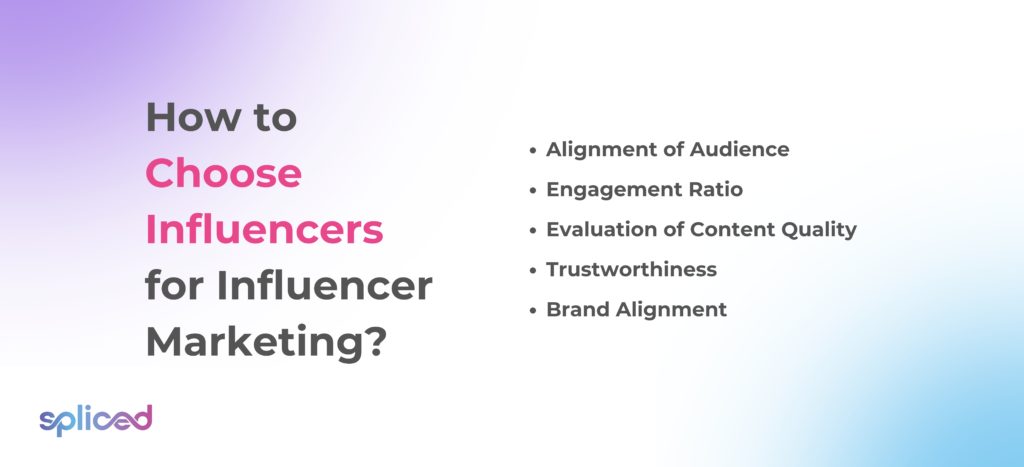
How to Choose Influencers for Influencer Marketing?
To choose influencers for influencer marketing, follow the guideline below.
-
- Alignment of Audience: Make sure the influencer’s following is composed of people who fall within the ideal demographic.
-
- Engagement Ratio: Seek influencers who have a high engagement ratio rather than merely big fan bases.
-
- Evaluation of Content Quality: Evaluate the level of quality and importance of the influencer’s content in relation to the brand.
-
- Trustworthiness: Pick influencers whose ads are trustworthy.
-
- Brand Alignment: One of the best ways on “how to find influencers” is to make sure that the influencer’s image and values are consistent with the values of the company they represent.

What are the different types of Influencers?
The different types of influencers are listed below.
-
- Nano-Influencers: Nano-influencers are individuals who often possess a follower count ranging from 1,000 to 10,000. Renowned for its exceptional level of user involvement and its ability to attract and cater to specific, specialized audiences.
-
- Micro-Influencers: Micro-influencers are individuals who own a follower base ranging from 10,000 to 50,000. They are frequently regarded as authorities in particular domains.
-
- Mid-Tier Influencers: Mid-tier influencers are characterized by having a follower count ranging from 50,000 to 500,000. They achieve a harmonious balance between the extent of their influence and the level of interaction.
-
- Macro-Influencers: Macro-influencers are individuals that have a substantial social media following, typically ranging from 500,000 to 1 million followers. These influencers possess a substantial level of influence and have the ability to reach a large audience.
-
- Mega-Influencers: Mega-influencers, as one of the types of influencers, are typically someone who possess celebrity status or are widely recognized people, with a substantial following of more than one million individuals. They offer extensive visibility.
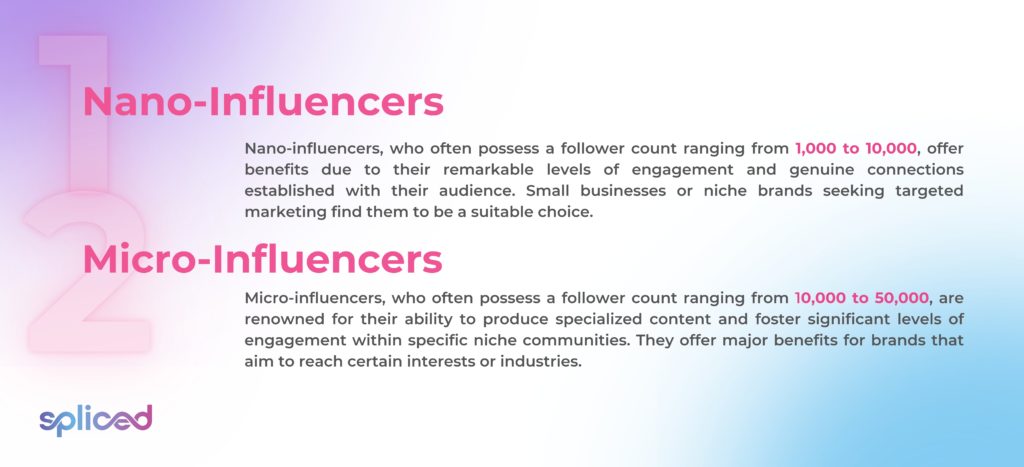
1. Nano-Influencers
Nano-influencers, who often possess a follower count ranging from 1,000 to 10,000, offer benefits due to their remarkable levels of engagement and genuine connections established with their audience. Small businesses or niche brands seeking targeted marketing find them to be a suitable choice.
Building a devoted following in a particular niche, actively interacting with the audience, and producing real content are the keys to becoming a nano-influencer. Their expenses for collaboration are typically minimal, and they occasionally take merchandise or minimal payment for endorsements. Searches on social media networks or platforms designed specifically for influencer marketing are a way to track down nano-influencers.
They are more cost-effective and get more people involved, but they are able to connect with a limited number of people and do not have as much experience working with others professionally.
Nano-influencers frequently exhibit elevated conversion rates as a result of their established and trusted connections with their audience. Influencers with greater followings tend to have higher average impressions, although less targeted and engaged.
2. Micro-Influencers
Micro-influencers, who often possess a follower count ranging from 10,000 to 50,000, are renowned for their ability to produce specialized content and foster significant levels of engagement within specific niche communities. They offer major benefits for brands that aim to reach certain interests or industries.
It takes specialized attention to detail, regular production of high-quality content, and genuine audience engagement to become a micro-influencer. The cost associated with engaging in partnerships with micro-influencers shows variation, although generally falls within a low range. The strategy presents a favorable balance between the extent of audience reached and the economical viability of such collaborations.
The best ways to find micro-influencers are through influencer lists or social media sites. One notable benefit of micro-influencers is their adeptness in efficiently targeting and engaging specific audiences but with a narrower scope compared to their larger influencer counterparts. Micro-influencers often exhibit favorable conversion rates due to the high trust they command within their communities. Their average impressions are higher compared to individual nano-influencers, which makes them useful for advertising aimed at particular demographics.

3. Mid-Tier Influencers
Mid-tier influencers, characterized by a follower count ranging from 50,000 to 500,000, effectively manage a trade-off between achieving a substantial reach and upholding a certain degree of personal interaction with their audience. They are particularly suitable for marketers seeking to reach a wider audience while avoiding the elevated expenses associated with macro-influencers.
Attaining mid-tier influencer status typically entails building up a significant and engaged audience while ensuring that the content remains captivating and relatable. The costs associated with collaborating with macro-influencers are comparatively higher than the ones associated with nano and micro-influencers, yet macro-influencers provide a broader scope of audience reach.
Influencer marketing networks and social media profiles of well-known individuals within particular niches are good resources for locating mid-tier influencers. Advantages include a larger audience and more engagement opportunities than macro-influencers, but perhaps not the same level of sway as with mega-influencers. Mid-tier influencers frequently exhibit a favorable balance between conversion rates and impressions, effectively reaching sizable yet specific target audiences.
4. Macro-Influencers
Macro-influencers, distinguished by their considerable follower count spanning from 500,000 to 1 million, present an optimal choice for brands seeking to optimize their outreach and enhance their prominence. These influencers are frequently recognized individuals who possess the ability to generate substantial awareness for a brand’s products or services.
A significant following must be developed over time, frequently by producing content appealing to a broad audience or becoming well-known in other ways to attain macro-influencer status. Some of the costs of working with them are high, which shows how far they reach. Brands often use influencer marketing companies or platforms to find macro-influencers.
One of the primary benefits of macro-influencers lies in their capacity to effectively engage with extensive target demographics and expedite the amplification of brand recognition. It is important to acknowledge several drawbacks associated with such an approach. These drawbacks encompass reduced levels of engagement when compared to influencers with smaller followings and increased expenses. Macro-influencers exhibit substantial conversion rates and great impressions due to their large follower base.
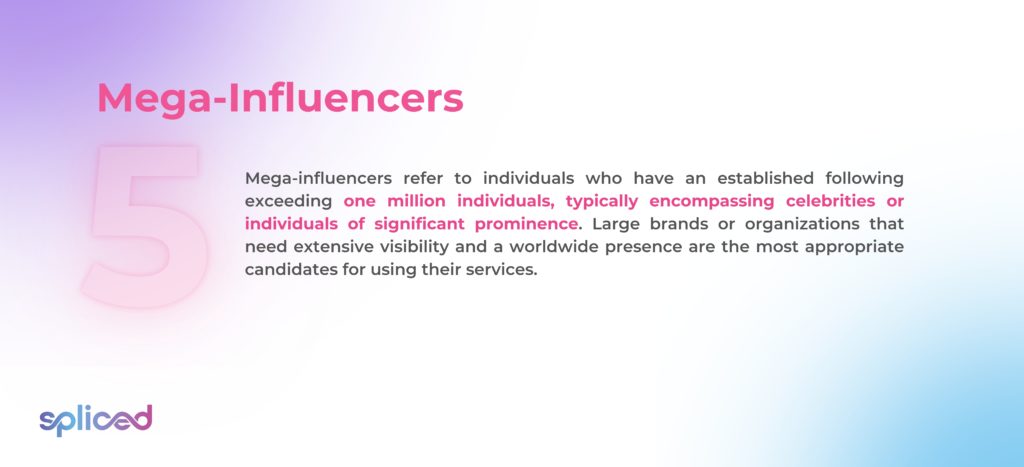
5. Mega-Influencers
Mega-influencers refer to individuals with an established following exceeding one million, typically encompassing celebrities or individuals of significant prominence. Large brands or organizations that need extensive visibility and a worldwide presence are the most appropriate candidates for using their services.
Attaining mega-influencer status typically entails garnering widespread acclaim or acknowledgment beyond social media, such as in entertainment, sports, or other public spheres. The expense associated with engaging in partnerships with prominent influencers is generally important, primarily attributable to their elevated stature within the public eye and extensive audience reach. Brands frequently communicate directly or through agencies with mega-influencers.
The advantages of mega-influencers encompass an unmatched level of reach and the capacity to exert influence on a significant scale. However, fees are involved, as well as the potential for lower engagement rates compared to smaller influencers, owing to their size. Mega-influencers frequently exhibit elevated conversion rates owing to their extensive reach and are capable of generating substantial impressions. It is worth noting that these impressions do not always possess the same level of specificity as ones derived from influencers with narrower, specialized audiences.
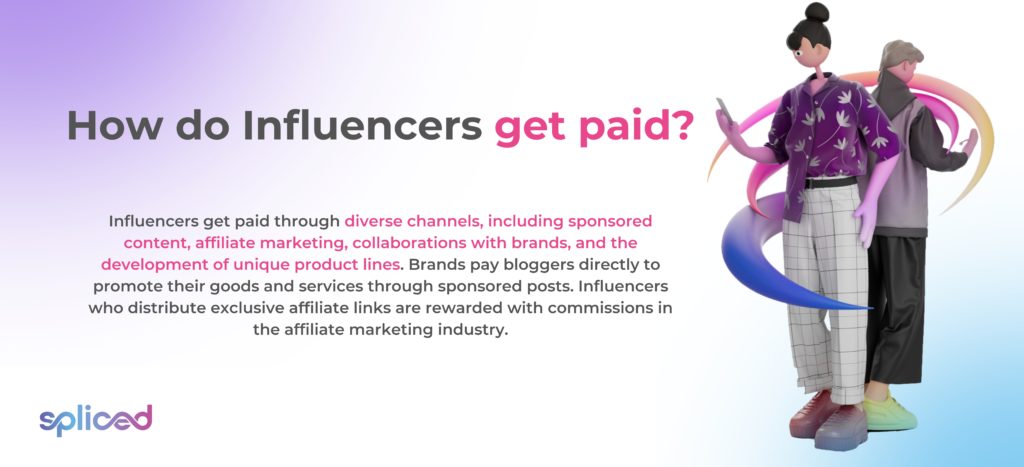
How do Influencers get paid?
Influencers get paid through diverse channels, including sponsored content, affiliate marketing, collaborations with brands, and developing unique product lines. Brands pay bloggers directly to promote their goods and services through sponsored posts. Influencers who distribute exclusive affiliate links are rewarded with commissions in the affiliate marketing industry. Sometimes, brands work with other brands to promote their goods regularly as part of long-term partnerships. Another common way that influencers make money is by selling their own items or services to their fan base. The influencer’s reach, engagement rate, and the details of their partnership with businesses determine the payment method and amount.
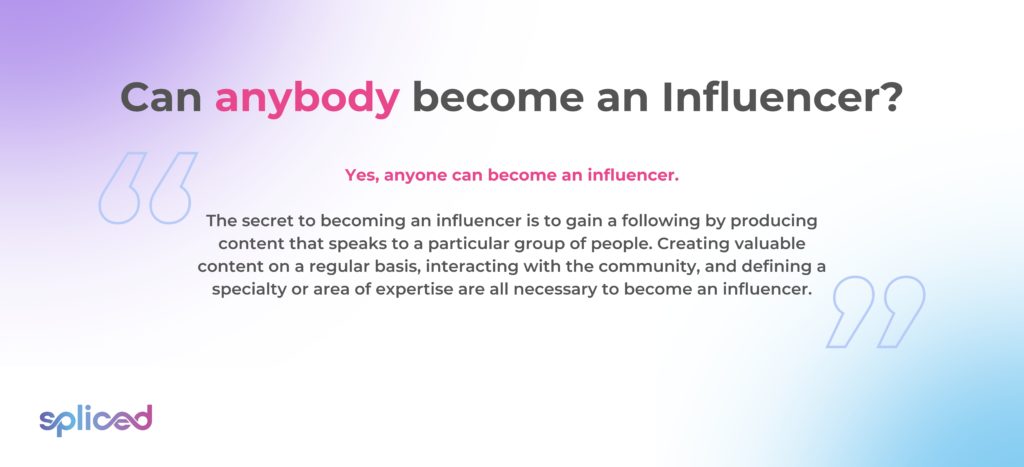
Can anybody become an Influencer?
Yes, anyone can become an influencer. The secret to becoming an influencer is to gain a following by producing content that speaks to a particular group. Creating valuable content regularly, interacting with the community, and defining a specialty or area of expertise are all necessary to become an influencer.
People from different origins and interests are able to express their opinions and grow a following on social media thanks to the democratization of these platforms. Understanding the selected platform’s dynamics, dedication, and creativity are necessary for the process. The attainment of success in becoming an influencer is not assured. It is based upon a wide range of circumstances, including the individual’s capacity to establish a connection with their audience and effectively respond to evolving trends.
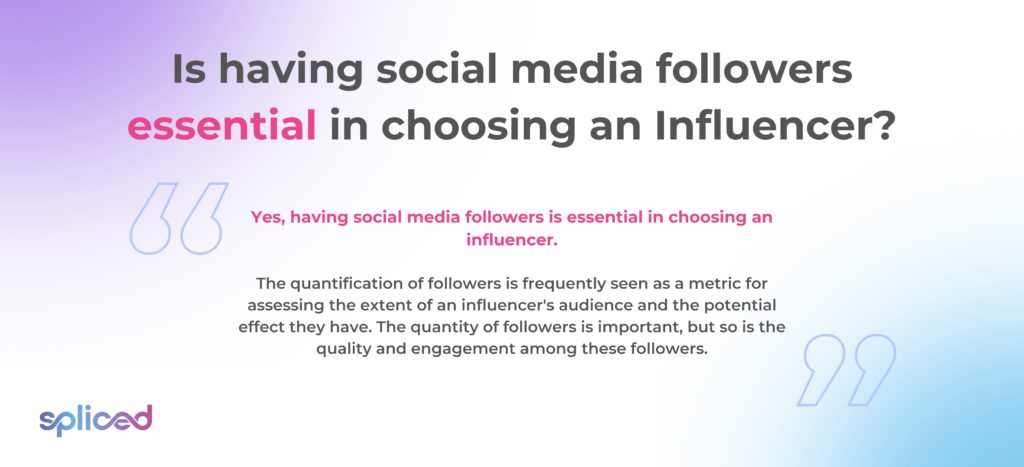
Is having social media followers essential in choosing an Influencer?
Yes, having social media followers is essential in choosing an influencer. The quantification of followers is frequently seen as a metric for assessing the extent of an influencer’s audience and the potential effect they have. The quantity of followers is important, but so is the quality and engagement among these followers.
Brands seek out influencers whose followers have a real interest in what they post and are more inclined to connect with it actively. It’s often better to have a small, active audience with a high engagement rate than a big one with a low engagement rate. The number of followers is, therefore, an important measure, but it must be taken into account along with engagement and relevance to the brand’s target market.
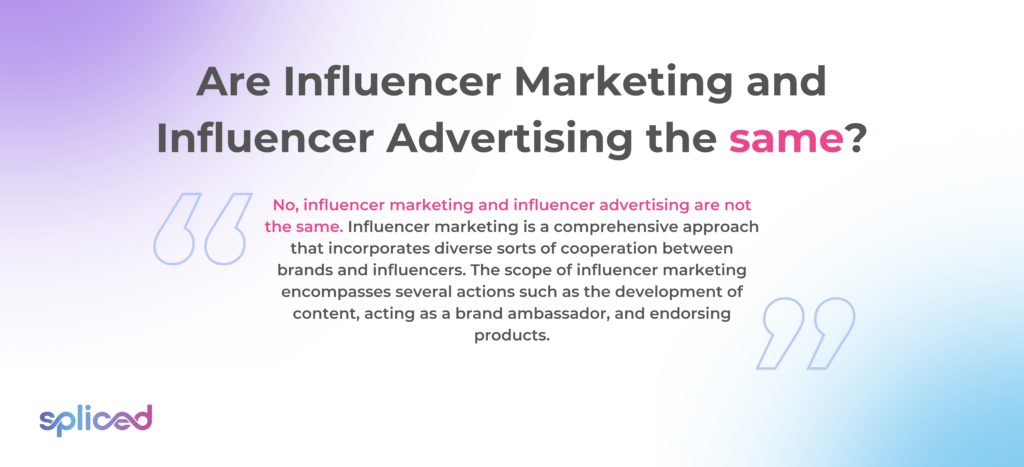
Are Influencer Marketing and Influencer Advertising the same?
No, influencer marketing and influencer advertising are not the same. Influencer marketing is a comprehensive approach incorporating diverse cooperation between brands and influencers. The scope of influencer marketing encompasses several actions, such as developing content, acting as a brand ambassador, and endorsing products.
Influencer advertising is a more precise term that typically pertains to endorsing a brand’s offerings or services by influencers in an approach that is overtly acknowledged as advertising, frequently through sponsored postings or compensated collaborations. Influencer advertising is often understood as a component of influencer marketing, which involves a broader spectrum of interactions and associations between businesses and influencers.
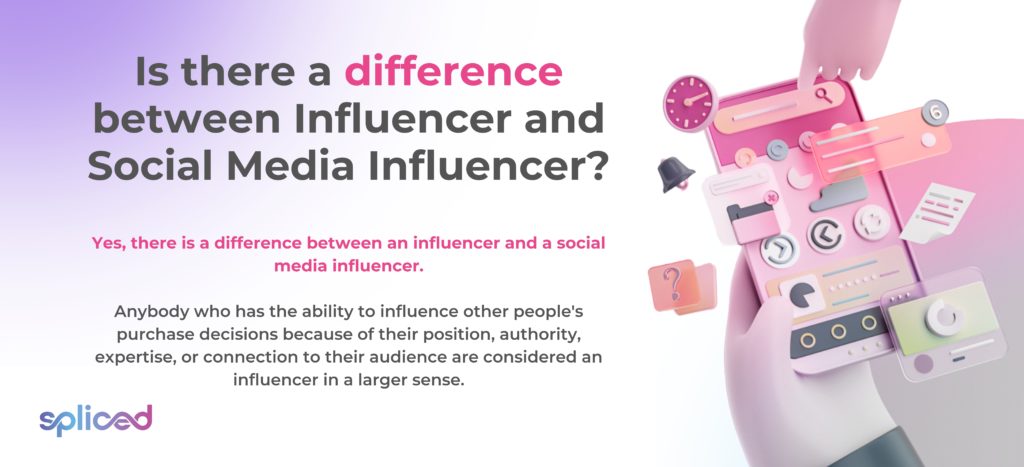
Is there a difference between an Influencer and a Social Media Influencer?
Yes, there is a difference between an influencer and a social media influencer. Anybody who has the ability to influence other people’s purchase decisions because of their position, authority, expertise, or connection to their audience is considered an influencer in a larger sense.
Online platforms are not the only domains in which the effect is able to be felt. A social media advocate, on the other hand, is someone who uses social media to spread their message. The extent of their impact is predicated upon the substance they disseminate and their engagement with their audience on these virtual mediums.
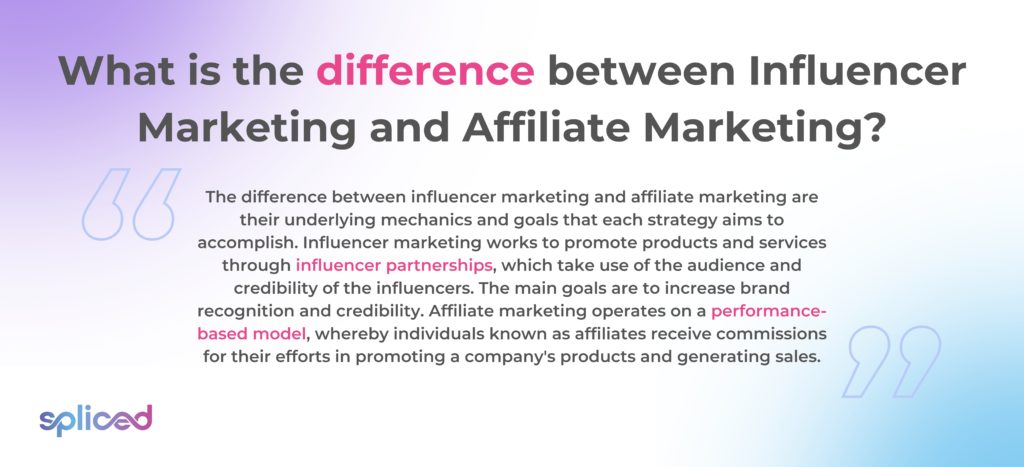
What is the difference between Influencer Marketing and Affiliate Marketing?
The difference between influencer and affiliate marketing is the underlying mechanics and goals each strategy aims to accomplish. Influencer marketing promotes products and services through influencer partnerships, which use the audience and credibility of the influencers. The main goals are to increase brand recognition and credibility.
Affiliate marketing operates on a performance-based model, whereby affiliates receive commissions to promote a company’s products and generate sales. The primary focus is using affiliate links for direct sales rather than engaging in more comprehensive brand promotion strategies. The focus of influencer marketing and affiliate marketing are widely different. Affiliate marketing has a closer relationship with sales performance than influencer marketing, while influencer marketing increases brand exposure and customer trust.
